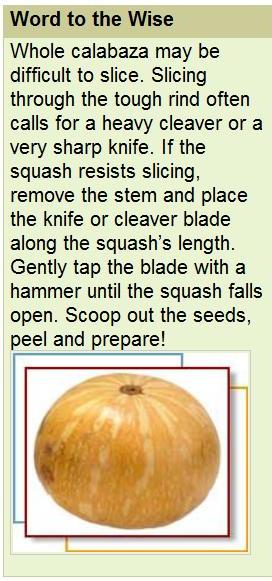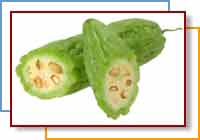Exotic Vegetables
Calabaza Squash
Calabaza is a type of pumpkin-like squash that is round in shape and varies in size. It can be as large as a watermelon or as small as a cantaloupe. The color of calabaza can also vary and may include greens, tans, reds and oranges. Some squash are all one color while other calabaza are multi-colored and may include all of colors listed above. This squash is popular in the Caribbean as well as Central and South America. It is also commonly called a West Indian Pumpkin.
Selection
Calabaza is often sold already chopped into chunks in many Latin markets. This is because of the difficulty many have in chopping the whole squash (see box below). Select pieces with a fresh, moist and unblemished flesh. Soft or wet spots means the squash is beginning to spoil. The color of the flesh should be a bright orange. Whole squash are more difficult to find, but if you find one, select one that still has the stem attached and is heavy for its size. You should avoid purchasing a squash with bruises, cuts, or soft spots. Calabaza is available year round.
Storage
Whole calabaza may be stored in a cool, dry space for up to 6 weeks. Cut calabaza should be wrapped tightly or placed in a covered container in the refrigerated for no more than one week.
Preparation
Calabaza has a sweet flavor and its texture is firm. This is similar to the taste and texture of more familiar varieties of squash, such as butternut or acorn. Calabaza may be substituted in recipes calling for those more common types of squash.
Calabaza is most commonly baked, either cut in sections or in cubes. Its seeds may also be roasted in a similar way as pumpkin seeds. Simply place on a baking sheet coated in cooking spray until brown and crisp.
Chayote Squash
Chayote is a gourd-like squash that is about the size and shape of a very large pear. The skin is pale green and smooth with slight ridges that run lengthwise. Many compare the color to a light green apple. The flesh is white and there is one soft seed in the middle. Chayote is grown in several states including California, Florida, and Louisiana, but it is native to Latin America. Historically, this squash was one of the primary foods of the Aztecs and Mayas. Chayote is also called mirliton and the French call it christophene.
 Selection
Selection
Select squash that are small, firm and unblemished; just as you would select a pear. Choose squash that is heavy for its size. Tender skin, skin that reacts to pressure, often means poor quality. Chayote is commonly found in supermarkets during peak season (December to March), but may be found in larger supermarkets and specialty markets throughout the year.
Storage
Refrigerate whole chayote in a plastic bag for up to one month. Cut chayote may be refrigerated in a covered container or tightly wrapped for 3 to 5 days. It is best to use chopped chayote immediately, as it can gather flavors from other foods stored in the refrigerator.
Preparation
Chayote has a bland-tasting flesh that may be used in several ways. It may be prepared in similar ways to other summer squash, such as zucchini, but may require peeling and a bit more seasoning. Chayote is most commonly used in side dishes, stews, and casseroles. It may also be sliced in half and baked. The soft seed is edible, but many choose to remove it.
Bitter Melon
Bitter melon is actually a member of the squash family and resembles a cucumber with bumpy skin. When first picked, a bitter melon is yellow-green, but as it ripens, it turns to a yellow-orange color.
The inside of the melon is filled with fibrous seeds. Bitter melon is used mostly in Asian and Indian cooking. Other names for bitter melon include: foo qua, balsam pear, or bitter gourd.
Selection
Select firm, unblemished melons that are from 5 to 12 inches in length. Choose melons that are still green for a more bitter flavor and a yellow-orange melon for a milder taste. Bitter melons are available fresh from April to September in most Asian markets and can occasionally be found in larger supermarkets. Some markets are beginning to carry bitter melons year round. They may also be purchased canned or dried.
Storage
Store melon loose in a paper or plastic bag in the refrigerator for 3 to 5 days. Slice the melon immediately before use.
Preparation
Cut in half and discard the seeds and fibrous core. To reduce the bitterness, blanch in boiling water for 2 to 3 minutes. The skin is edible and the melon is not typically peeled. The seeds are also edible, unless very hard, and are included in some recipes. Bitter melon is commonly stuffed, curried or pickled. It can also be used in stir-fry’s and soups and may be steamed. Garlic or chili peppers are often added to recipes with bitter melon to offset the bitter taste






















